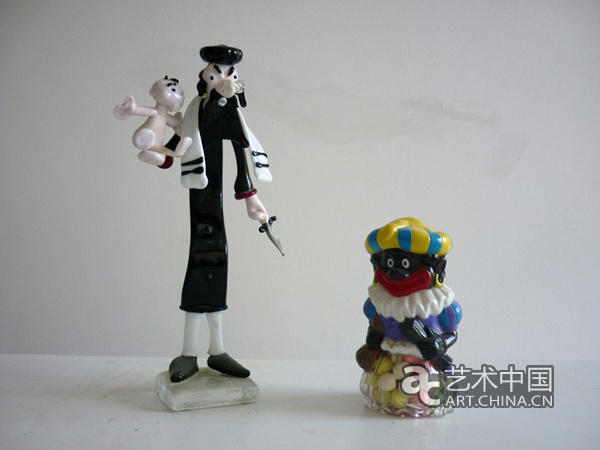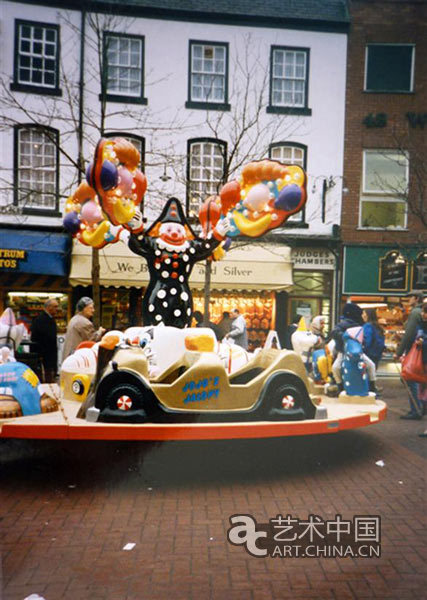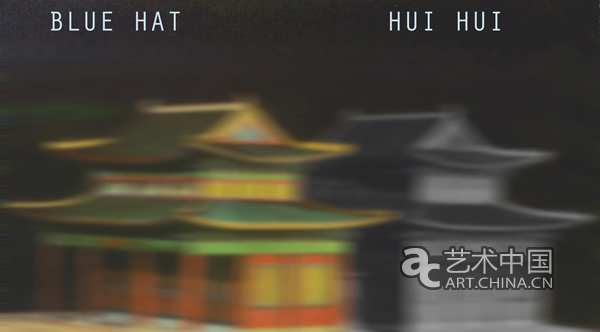
Glass Jew Toy
玻璃犹太人玩偶
Made of Venetian glass, 30 cm long, a figure of a jew holding a knife and a baby. Bought in Venice.
A sweet holder figurine with a minstrel face, 11cm long, bought in Amsterdam, part of a paraphernalia attached to the celebrations of St. Nicholas, where young people depicting 'Zwarte Pieten' (Black Petes) traditionally paint their faces black.
犹太人手持一把小刀和一个婴儿,威尼斯玻璃制成,30cm长,购于威尼斯。
一座拿着糖果的吟游诗人小雕像,11cm长,购于阿姆斯特丹,雕像周身佩戴着用于圣尼古拉斯庆典的一些用具。阿姆斯特丹的年轻人将其称为“黑彼得”(Zwarte Pieten),并且有将他们的脸画成黑色的传统。

Clown in Leicester , colour print,10x12cm
小丑,彩色印刷,10x12厘米

Blue Hat, Hui Hui (Kaifeng Synagogue), lambda print, 2010, 90x50cm
蓝帽,回回(开封犹太宫殿),照片打印,2010,90x50厘米
Archaelogical evidence suggests that Jews were in China as early as the 8th Century, having arrived from Persia along the Silk Road. In 1163 the Emperor ordered the Jews to live in Kaifeng, where they built the first Chinese synagogue. Marco Polo recorded that Kublai Khan celebrated the festivals of the Muslims, Christians and Jews, indicating that there were a significant number of Jews in China in the 13th Century.
A Ming Emperor conferred on the Jews seven surnames - Ai, Lao, Jin, Li, Shi, Zhang and Zhao. To this day Chinese Jews will only have one of these seven names. Christian missionaries also recorded meetings with Chinese Jews. At least one synagogue was constructed, and the community was active for about eight centuries. Currently, the Vatican holds letters from Jesuits in the 18th Century describing the daily life and religious practices of Jews in Kaifeng, and drawings of their synagogue.
( from internet)
考古证明犹太人早在公元8世纪就已经出现在中国,他们是从波斯沿着丝绸之路来到中国的。在1163年,宋帝同意犹太人“留遗汴梁(今开封)”,他们在那里建立了第一个中国犹太教堂。据马可波罗记载,大汗忽必烈与穆斯林、基督教徒和犹太人一同庆祝过他们各自的节日。这暗示了在13世纪的中国,犹太人已经不在少数。
明朝皇帝赐给犹太人七个汉姓,分别是艾、高、金、李、石、张、赵。直至今日,中国的犹太人仍然沿用着七个汉姓中的一个。至少有一座犹太教堂建立并且保持了长达八个世纪的活力。现在梵蒂冈扔保存着18世纪耶稣会信徒的信件,它们描绘了当时开封犹太人的日常生活和宗教活动,并且画出了他们的教堂。(来自网络资源)